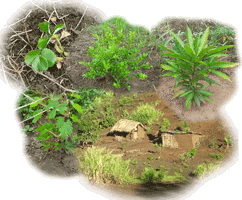
This experiment holds two aspects:
![]() A Tanzanian farm of two hectares whose
purpose is to experiment fruit-tree varieties. This farm, of which I
manage the technical aspects, is entirely financed on personal funds.
A Tanzanian farm of two hectares whose
purpose is to experiment fruit-tree varieties. This farm, of which I
manage the technical aspects, is entirely financed on personal funds.
![]() An fruit-tree extension project, like
mango-trees or apple-trees among villagers which aims at food security
improvement, culture diversification, and nutritional intake. This
is for this last component that crowdfunding has been launched.
An fruit-tree extension project, like
mango-trees or apple-trees among villagers which aims at food security
improvement, culture diversification, and nutritional intake. This
is for this last component that crowdfunding has been launched.
The link between the two of them is the technical resources for the development project as well as the research results conducted on the tempered species adaptation to this climate and this altitude.
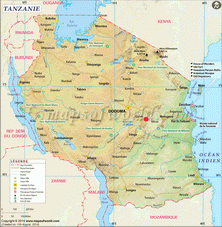
I knew the village of Chabima in 1984 when I was working for a project based at the Agriculture University of Morogoro ) Maendeleo ya bustani whose purpose was the creation of vegetable gardens, orange-tree and mango tree nurseries in the villages, and implantation, as a trial, of oil-palm trees.
I then went working in other places like Cameroon, Mali, Congo, Sudan in riral development projects as a agriculture coordinator. I then went to Mayotte, a French island from the Comoros archipelago where I stayed for 13 years. This closeness to Tanzania allowed me to quite often come back in the country.
Since my departure in 186 I came back many times in the village when the idea of a fruit-tree project in the valley of Chole, in Chabima, has sprouted at an altitude of 800, with the help of an ancient project trainee, Luka and his son Emanueli. It helped me keeping up with my level in Swahili, which I speak fluently, as well as English.
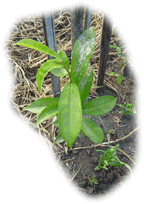
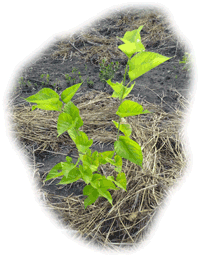
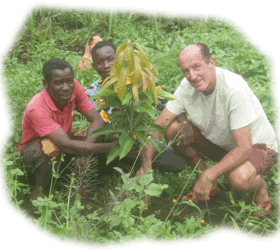
Lychee Mulberry tree
Luka, Emanueli (Kimsi) and me at the foot of a one-year old grafted mango tree
We had to reorganize the project in the following way:
 One hectare of "secure" production, like mango-trees, which will provide
an income.
One hectare of "secure" production, like mango-trees, which will provide
an income.
 One
hectare at least of fruit-tree and berry trials, which are found at the
moment in some other mountainous regions of Tanzania like Mbeya, Uluguru
Mountains, Songwe, Lushoto:
One
hectare at least of fruit-tree and berry trials, which are found at the
moment in some other mountainous regions of Tanzania like Mbeya, Uluguru
Mountains, Songwe, Lushoto:
 Apples, peaches, pears, plums
Apples, peaches, pears, plums
 White table grapes
White table grapes
 Strawberries, raspberries, blackberries,
mulberries
Strawberries, raspberries, blackberries,
mulberries
 Half
a hectare of trees whose seeds have been imported:
Half
a hectare of trees whose seeds have been imported:
 Lychees,
different grape varieties
Lychees,
different grape varieties
 Half
a hectare of trees imported from other regions of Tanzania for a trial or
to show the possibilities of cultivation: coffee-trees, clove-trees...
Half
a hectare of trees imported from other regions of Tanzania for a trial or
to show the possibilities of cultivation: coffee-trees, clove-trees...
 Lychees,
mango-trees and apple-trees, some peach-trees of early, common and late
varieties have been tried so to get a harvest spread on several months.
Lychees,
mango-trees and apple-trees, some peach-trees of early, common and late
varieties have been tried so to get a harvest spread on several months.
Chabima center is 600m high, on the road going to Lumuma. the valley of Chole is 5 km away from the center, towards East, surrounded by the Usagara Mountain forest reserve. the altitude of 800 m allows mild temperatures et boosts precipitations.
Usagara Mountains ground has a classic granitic from the African shield. Tectonic movements from the Rift Valley, responsible for the formation of the Kilimanjaro, has however caused an important metamorphism in the area. Schist and gneiss are found with outcrops of calcite. River sands present an important rate of mica, with a classical ratio of feldspar and quartz.
Soil itself is quite rich in those recently cleared valleys, with terracing which leads to a quick erosion where remains only the clayey subsoil which is rich in iron but poor considering the nutriments.
Chole Valley presents a a more humid and cooler climate than the village. Rainy season starts ad mid-December et ends at the end of May, with a small dry season in February. Climatic hazards are now frequent, with sometimes a small rainy season almost non-existent, or severe droughts from June to December.
Rainfall is estimated to 1 800mm. Temperature stays mostly around 30°C, with drops at night to 13 to 14° in June and July. Those temperatures should allow almond-trees and apricots cultivation.
Chabima village maintains long-time felt agricultural traditions. Innovations are scarce and a sole failure may condemn a crop.
Traditionally maize and bean are cultivated, the latter being a cash crop. Here and there pigeon pea, pumpkin or sweet potato and some vegetables in a garden. Irrigation is little practiced.
Inhabitants show a deficit in vitamin C, children mainly. "Local" mango trees give some sour mangoes with no commercial value. Apart from those mangoes, the zambarao and the guavas, there is no other fruit but some scarce orange-trees of little juice variety and some mandarin-tree. The lemon-tree with thick skin fruit are used as a root-stock when grafting.
Harvest is later in the season than in Kilosa, located in the plain 50 km away. Early, common and late varieties would allow to spread the village production whicjh would allow commercial advantages, buyers coming thus from Kilosa.
Enlargement of the path, realized by my own funds let small
lorries to reach the hamlet of Chole.
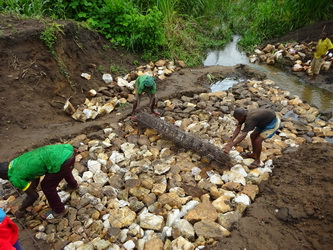
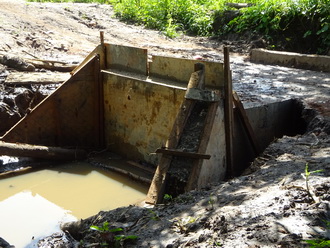 Building
an apron on the Mlolwa river
Building
an apron on the Mlolwa river
All the research and trials part is financed by personal funds on the fields of villagers.
This research concerns fruit-tree growing in the Chole Valley but also in lower areas like Mlolwa or areas at the village level at the altitude of 600m.
This extension project leans on several observations:
As some friends in Dar es Salaam were enthusiastic for the project we created a local NGO named FAID (Friends for Agriculture Initiatives Development) which hires me as an agriculture technician, with a voluntary status granting me a staying permit allowing me to set up this project.
Euremetyne MWACHA alias Papaa, a computer engineer, acts as a director. As well as the other members of the board he stays in Dar es Salaam. Only Emanueli, member of the board, and me stay in Chabima.
Collected funds are directly managed by me and Emanueli.
In some areas were cultivated cover plants like pumpkins, edible leaves like amaranth which could grow at the foot of maize stems without hindering the light but helping fixing the soil. The appeal for cash crops has privileged an only culture with wiping out cover plants which leaves a naked soil after hoeing.
The mango spread in Africa from the 15th century was similar to the original wild mango. It is only 30 years ago that early, "normal" and late varieties grafted mango trees with an abroad potential commercial value appeared, but they have not replaced yet the old mango trees planted by the elders in the villages.
Several fruit-tree species will be proposed to the villagers: apple trees, which are being on trial at this altitude, table grapes, peaches, lychees, and so forth... It allows a culture diversification as well as the sale spreading on several months. Another aspect concerns vegetable growing, which is up to now of little practice but which has a great local market: in Kilosa, Morogoro or Dar es Salaam for instance.
Tanzania is considered as a developing country with a typical economics pattern found in these countries: most inhabitants depend on agriculture, wood export are raw and there is few industries, although most of the economics are informal ("the resourcefulness"). Income is estimated at 2 euros per inhabitant but rather 1 euro in the countryside.
Medical expenses, clothing, phone charges, transportation, cooking oilsalt and sugar are the main items which need an income. Houses are made out of cobon a pole frame got from the forest and They are coated with mud. They are covered with thatch gradually replaced by sheets while the walls are built of locally fired bricks. The furniture in the best case sticks to a coffee table et some small benches for getting a meal but in most cases a common dish is presented on the floor with diners seated on a mat. Bags are used for storing. The unique room, separated in two parts by a cloth is used for one side as a bedroom when for lack of bed and mattress is strewn with dry banana leaves covered with a mat. Agriculture tools is limited to a hoe and a bush knife. Tools I could bring like a shovel, a pick-axe or the grass-cutter were immediately adopted and used.
The habit is to leave early to the field. Meal is taken around 2 pm at home or in the field. Women are in charge of cooking on a firewood, go and fetch water to the river was clothes, clean... It is a patriarchal regime, where man also decides for his children, employing them as his servants. In some families this role is so pronounced that children leave the premises.
Men clear land, plow, women help with sowing. The men harvest except when the field is exploited by the woman who ensures all the production. There is a lot of help, whether for emergency crops or building a house..
The diet is based on corn in the form of dough (dried, mashed corn is put to cook in boiling water) and beans. Next to it is the sauce, consisting of beans or leaves (amaranth, squash ...). On the occasion of the arrival of a stranger, a party or a holiday a chicken is cooked.
The inhabitants are in the majority Christians, few practitioners, with a respect for ancestral customs such as hunting a demon, or counter a bad fate. Men can be polygamous, but the majority are monogamous.
The telephone has become essential in communication, and most residents are equipped with it.
The road to Kilosa is a track. It is a little maintained at the end of the rainy season, which makes it possible to reach Kilosa in just under an hour. The rain digs many gullies, fells trees and trucks dig ripples making it difficult to progress. The journey of fifty kilometers then takes an hour and a half or more. A 4x4 is essential, and this 4x4 must be a pick-up to transport the plants to the village. It will also be used for monitoring, market research and marketing when teams of farmers are formed.
Sick people are transported by motorcycle, sometimes tied up on the motorcycle with another person supporting them in the back. This 4x4 would obviously help transport to the hospital in case of need
Farmers tend to stick to a form of maize and bean monoculture without seeking improvement or diversification. Our goal is to introduce permaculture, which respects the abundance of a forest. Between the tree seedlings we planted sunflowers and squash or watermelons, and the trees are not grouped by species but planted here and there. It is essential to organise training sessions in the following areas:
 Awareness of
soil cover: erosion, role of roots, earthmoving techniques, importance of
cover crops.
Awareness of
soil cover: erosion, role of roots, earthmoving techniques, importance of
cover crops.
 Establishment
of nurseries for grafting plants on local lemon to obtain citrus fruits as
diverse as orange, lemon (lime), grapefruit, pomelos, mandarin ... and
Sindano mango trees to graft more productive mango trees.
Establishment
of nurseries for grafting plants on local lemon to obtain citrus fruits as
diverse as orange, lemon (lime), grapefruit, pomelos, mandarin ... and
Sindano mango trees to graft more productive mango trees.
 Marketing
awareness: if the village is known as a producer marketing will be easier
and trucks will come to pick up the products.
Marketing
awareness: if the village is known as a producer marketing will be easier
and trucks will come to pick up the products.
The financing sought concerns the distribution of fruit tree seedlings to the villagers of Chabima and other villages if the funds allow it:
 Purchase of
grafted seedlings in the garden of the University of Morogoro, apple and
mango trees
Purchase of
grafted seedlings in the garden of the University of Morogoro, apple and
mango trees
 Transport of
these plants to Chabima and possibly to Chole
Transport of
these plants to Chabima and possibly to Chole
 Establishment
of lists of beneficiaries, in connection with the notables and leaders of
the village
Establishment
of lists of beneficiaries, in connection with the notables and leaders of
the village
 Sale
at a reduced price so that villagers "appropriate" their trees and be
responsible
Sale
at a reduced price so that villagers "appropriate" their trees and be
responsible
 Establishment
of individual or collective mango and lemon tree nurseries
Establishment
of individual or collective mango and lemon tree nurseries
 Grafting of
those plants
Grafting of
those plants
 Supervision
of nurseries and plants distributed, advice on pruning, maintenance and
possibly storage
Supervision
of nurseries and plants distributed, advice on pruning, maintenance and
possibly storage
 Common
marketing strategy
Common
marketing strategy
 The
difficulties are based on the motivation of the villagers:
The
difficulties are based on the motivation of the villagers:
 Acquisition of cheap seedlings villagers for resale in other
villages thereafter
Acquisition of cheap seedlings villagers for resale in other
villages thereafter
 Disinterest in maintenance, which leads to the death of
plants
Disinterest in maintenance, which leads to the death of
plants
 The
strengths are as follows:
The
strengths are as follows:
 The funding requested is to invest in plants and their
transportation. Only a few casual daily workers will receive compensation
The funding requested is to invest in plants and their
transportation. Only a few casual daily workers will receive compensation
 The project is led by a person with long experience of
development projects, fluent in English and Swahili, well integrated in
the village
The project is led by a person with long experience of
development projects, fluent in English and Swahili, well integrated in
the village
 Monitoring is technical and scientific, with a research
component, all resulting in quarterly online reports
Monitoring is technical and scientific, with a research
component, all resulting in quarterly online reports
 The project can be visited at any time by contributors
The project can be visited at any time by contributors
 The project is part of a sustainable development action
The project is part of a sustainable development action
 The project includes training sessions and not just plant
inputs
The project includes training sessions and not just plant
inputs
Vincent Elouard